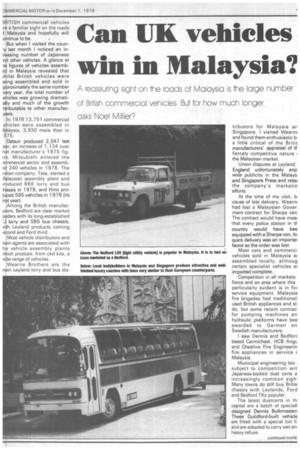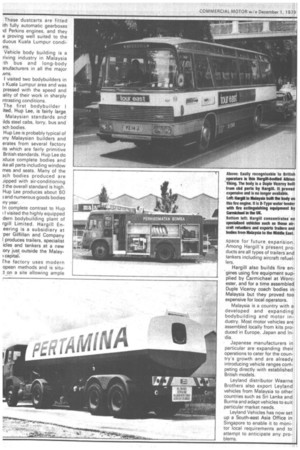Can UK vehicles hi hi Malaysia?
Page 49

Page 50

If you've noticed an error in this article please click here to report it so we can fix it.
A reassuring sight on e roac s of Malaysia is e large number of British commercial vehicles. But for how much longer asks Noel Viliier?
ITISH commercial vehicles qa familiar sight on the roads ,f Malaysia and hopefully will
o tinue to be.
But when I visited the coun last month I noticed an in asing number of Japanese ni other vehicles. A glance at -1 figures of vehicles assemb.i in Malaysia revealed that
ilst British vehicles were ,erig assembled and sold in pProximately the same number very year, the total number of
e icles was growing dra matia ly and much of the growth t ibutable to other manufacers.
In 1978 13,751 commercial e icles were assembled in laysia, 3,930 more than in 75.
Deism produced 2,347 last e r, an increase of 1,134 over
t manufacturer's 1975 figire. Mitsubishi entered the ommercial sector and assernb?,d 240 vehicles in 1978. The n jian company, Tata, started a A laysian assembly plant and ir duced 668 lorry and bus ssis in 1978, and Nino proI ced 596 vehicles in 1978 (its ir.t year).
Among the British man ufac u ers, Bedford are clear market ders with its long-established
lorry and SB5 bus chassis, vi h Leyland products coming.
e end and Ford third.
Most vehicle distributors and n in agents are associated with h vehicle assembly plants ✓ ich produce, from ckd kits, a viie range of vehicles. INearne Brothers are the
.tributors for Malaysia ar Singapore. I visited Wearni and found them enthusiastic bi a little critical of the BritiE manufacturers' appraisal of IIfiercely competitive nature the Malaysian market.
Union disputes at Leyland England unfortunately enjc wide publicity in the Malays and Singapore Press and retar the company's marketin efforts.
At the time of my visit, b cause of late delivery, VVearni had lost a Malaysian Gayeri ment contract for Sherpa van The contract would have meal that every police station in th country would have bee equipped with a Sherpa van, bi quick delivery was an importar factor so the order was lost..
Most cars and commerci. vehicles sold in Malaysia ai assembled locally, althoug certain specialist vehicles ar imported complete.
Competition in all markets fierce and an area where this particularly evident is in fin service equipment. Malaysia fire brigades had traditionall used British appliances and st, do, but some recent contrac• for pumping machines an hydraulic platforms have bee awarded to German an Swedish manufacturers.
I saw Dennis and Bedforc based Carmichael, HCB Angu and Cheshire Fire Engineerin fire appliances in service i Malaysia.
Municipal engineering too subject to competition wit Japanese-bodied dust carts a increasingly common sigh• Many towns do still buy Britis chassis with Leylands, Ford and Bedford TKs popular.
The latest dustcarts in th capital are a batch of speciall designed Dennis Bulkmasten These Guildford-built vehicle are fitted with a special bin Ii• and are adapted to carry wet an heavy refuse. These dustcarts are fitted ith fully automatic gearboxes id Perkins engines, and they e proving well suited to the duous Kuala Lumpur condims.
Vehicle body building is a riving industry in Malaysia th bus and long-body 3nufacturers in all the major NOS.
I visited two bodybuilders in 3 Kuala Lumpur area and was pressed with the speed and ality of their work in sharply ntrasting conditions.
The first bodybuilder I ited, Hup Lee, is fairly large
Malaysian standards and ilds steel cabs, lorry, bus and 3ch bodies.
Hup Lee is probably typical of my Malaysian builders and erates from several factory its which are fairly primitive British standards. Hup Lee do )duce complete bodies and Ike all parts including window ries and seats. Many of the ach bodies produced are dipped with air-conditioning the overall standard is high. Hup Lee produces about 60 and numerous goods bodies ry year.
In complete contrast to Hup I visited the highly equipped dern bodybuilding plant of rgill Limited. Hargill Eneering is a subsidiary at per Gilfillan and Company I produces trailers, specialist ides and tankers at a new ory just, outside the Malaycapital:
rho factory uses modern opean methods and is situop a site allowing ample space for future expansion. Among Hargill's present products are all types of trailers and tankers including aircraft refuellers.
Hargill also builds fire engines using fire equipment supplied by Carmichael at Worcester, and for a time assembled Duple Viceroy coach bodies in Malaysia but they proved too expensive for local operators.
Malaysia is a country with a developed and expanding bodybuilding and motor industry. Most motor vehicles are assembled locally from kits produced in Europe, Japan and India.
• Japanese manufacturers in particular are expanding their operations to cater for the country's growth and are already introducing vehicle ranges competing directly with established British models.
Leyland distributor Wearne Brothers also export Leyland vehicles from Malaysia to other countries such as Sri Lanka and Burma and adapt vehicles to suit particular market needs.
Leyland Vehicles has now set up a South-east Asia Office in Singapore to enable it to monitor local requirements and to attempt to anticipate any problems.
















































































































